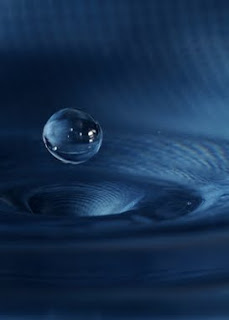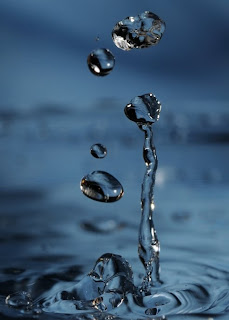 It's a new year and I find myself starting 2011 doing exactly what I was doing this time last year - playing with water. In Jan 2010 I was on module 5, studying motion photography and 'freezing' the action of a dripping tap into a bowl of water. This time I'm revisiting this subject for my macro module and attempting to get a bit more technical....
It's a new year and I find myself starting 2011 doing exactly what I was doing this time last year - playing with water. In Jan 2010 I was on module 5, studying motion photography and 'freezing' the action of a dripping tap into a bowl of water. This time I'm revisiting this subject for my macro module and attempting to get a bit more technical....I was inspired by the amazing photographs of Corrie White and her very helpful how-to-guide. Corrie uses approx. $500 of electronics to release drops at precise intervals and synchronise this with her shutter, but she also includes some good tips for using a more basic setup. The rest of this blog entry is the technical details and tips/tricks that I learned during the painstaking but hugely fun process so far....
The technical stuff:
This is Corrie's example setup that I replicated in my kitchen with an upturned chair.

An example of a droplet setup (see Corrie's guide for more...)
I played with various backgrounds and 'drippers' and 'drip recepticals'. The drippers I tried were - a plastic dropper which released drops when you squeeze the bulb, a drinks can with either a 2-3mm hole in its base or a 1cm slot (cut with a stanley knife blade), and a squeezy bottle with a nozzle dispenser on it. The dropper and the squeezy bottle gave nice small drops which were ideal for the individual droplet pictures (or pictures with just a few small drops like the one below).
The drinks cans were to create big splatty droplets that would stir up the water a lot and these created some of the most interesting shapes and multi-drop pictures (see below).
 For 'drip recepticals' I tried a variety of different bowls and a oven tray. Because the depth of field of the macro lens is so shallow the ideal position to get the whole event in focus would be to photograph at 90 degrees to the drip stream. This is impossible though, because whatever you're dripping into will get in the way. The tray is the best option since it has the shallowest side profile so you can photograph at an angle flatter to the surface of the standing water. You do need a slight angle though if you're going to see the ripples. This issue meant that a lot of the time the incoming drip and the impact site aren't both in focus which is what you really want. The best you can do is increase the f# as far as possible with the fast shutter speed you need to freeze the action, and to image at as shallow an angle to the water surface as possible.
For 'drip recepticals' I tried a variety of different bowls and a oven tray. Because the depth of field of the macro lens is so shallow the ideal position to get the whole event in focus would be to photograph at 90 degrees to the drip stream. This is impossible though, because whatever you're dripping into will get in the way. The tray is the best option since it has the shallowest side profile so you can photograph at an angle flatter to the surface of the standing water. You do need a slight angle though if you're going to see the ripples. This issue meant that a lot of the time the incoming drip and the impact site aren't both in focus which is what you really want. The best you can do is increase the f# as far as possible with the fast shutter speed you need to freeze the action, and to image at as shallow an angle to the water surface as possible.The camera/lighting setup that gave me the best results was as follows: Camera was tripod mounted, I used my Nikon 105mm macro lens with VR off (since this can actually add camera shake when you're using a tripod), on manual focussing (more on this later). I used ISO 200, f10-18 depending on the light levels, and a shutter speed of 1/250 to sync with the flashgun. I used both the on camera flash and wirelessly commanded my SB600 from it. Both operated on rear-sync. I positioned the flashgun at 90 degrees to the lens to give strong side-lighting to highlight the shapes made by the splashing water.
Tricks I used:
Focussing was a major pain. The key point is to make sure the 'dripper' (whatever it may be) is securely fixed and therefore dripping into the same point each time, when using a dropper I found this was really hard because just squeezing the dropper bulb was enough to wiggle the dropper around by a mm or so and this caused a lot of variation in the impact site. For later experiments when I was using punctured drinks cans a lot of the water was running off along the bottom of the can and dripping elsewhere, and depending on the amount of water in the can and the speed of the stream it's direction changed by a huge amount. It was worth the pain though because some of the coolest pictures came from the giant drops that these big streams created. For a fixed drip site you can put a focussing aid into the bowl centered under the drip stream (I used a small fridge magnet) so that you can then easily focus on that point, remove it and then away you go. For the big dripper like the cans, whose drip streams constantly changed direction, you just have to look through and manually refocus on what little you can see of the stream as it flashes past whilst tracking with the tripod. This is a painful process and you're relying on luck more than anything.
One thing to consider i
 s the background you use. With a tray you can put stuff in the bottom, like coloured card, which works really well and 'colours' the water. For my favourite pictures I used a blue cleaning cloth and tucked under and around the pyrex bowl I was using. The texture of the cloth comes through in some of the shots and gives an impression of waves (you can see this effect clearly in the 'vortex' under the single droplet at the top of this post).
s the background you use. With a tray you can put stuff in the bottom, like coloured card, which works really well and 'colours' the water. For my favourite pictures I used a blue cleaning cloth and tucked under and around the pyrex bowl I was using. The texture of the cloth comes through in some of the shots and gives an impression of waves (you can see this effect clearly in the 'vortex' under the single droplet at the top of this post).One neat trick is that the droplets themselves can produce images of what's behind them. I thought this was super cool and intially tried to give it something to image - I used a glass chopping board with an image of the manhatten skyline on it and placed it upside down behind the bowl (because the droplet will produce an inverted image). The trick is then to find the exact right distance to put the background image at, since you won't know the focal length of the drop - so again, relying on luck here. My best effort is seen here on the left, and below in closeup. It's grainy and ill-focussed, but you get the general idea. I might revisit this later....
Manhattan in a droplet of water....sort of.
Conclusions?
I found this to be seriously addictive. What I love about this type of photography is that there is a massive amount of luck involved, so you never know what you're going to get when you look at that viewscreen. You can spend hours (or at least I can!) fiddling with all the messy details and taking hundreds and hundreds of shots because you're convinced that the next one is going to be awesome. What happens most often is that there's no water in the photograph at all, or there is and it's badly focussed. But that doesn't matter if you just believe...I can see how droplet photography can become an obsession and why people would fork out $500 for the electronics to chase that dream of the perfect drop.


No comments:
Post a Comment